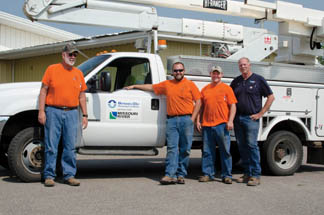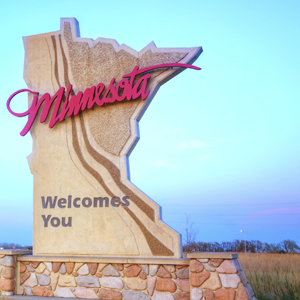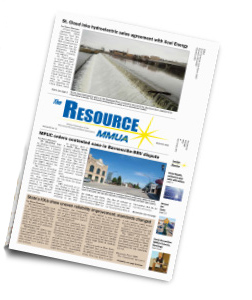
- SINCE 1931
- Cart 0
- Log In
Why Create an Account?
Access members-only information including complete utility directory, salary surveys, discussion forums, legislative updates and more.
Create an Account- Classifieds
- Forum
About MN's Municipal Utilities
Meet Minnesota's Municipal Utilities
Current Industry Structure
The electric utility industry is comprised of municipal utilities, cooperatives and investor-owned utilities.
Municipal utilities are governed by the city council or appointed utility commission. Municipals are non-profit. Capital is raised through operating revenues or sale of tax-exempt bonds. There are 124 municipal electric utilities in the state, and they serve approximately 386,000 customers. Regulation is largely through the local council or commission. Various safety and service issues are regulated by the state PUC or federal government. Municipals also occasionally address wholesale power and transmission transactions at the Federal Energy Regulatory Commission.
Cooperatives are governed by an elected board of directors. Those cooperative customers whose name appears on a bill are eligible to vote for directors. Cooperatives are non-profit entities but make a ‘margin’ on sales. Cooperatives often access funds through the federal Rural Utilities Service, or the National Rural Utilities Cooperative Finance Corporation (CFC), a privately owned, non-governmental organization. Traditionally, cooperative boards set their own rates. Cooperatives serve approximately 853,000 customers.
Investor-owned utilities, also known as IOUs, are governed by a board of directors elected by stockholders. IOUs are a state-regulated monopoly. They exist to make a profit for their stockholders while serving the public. Capital is raised through stock sales, taxable bonds and through operating revenues. Four IOUs operate in Minnesota. Investor-owned utilities comprise the largest segment of the industry in Minnesota, serving over 1.5 million customers. IOUs are regulated by the Minnesota Public Utilities Commission (PUC).
Big and Small (but mostly small)
There are 124 municipal electric and 33 municipal gas utilities in Minnesota (some cities with municipal electric utilities also operate municipal gas utilities; other cities operate a gas utility but not an electric utility). These utilities are located throughout the state. See the state map for their locations.
By far the largest municipal electric utility is Rochester, which serves a city of approximately 123,000 people. The next largest municipal, Moorhead, is much smaller, with a population of approximately 44,000 . The other municipal electric utilities with more than 10,000 customers are Alexandria, Anoka, Austin, Chaska, Elk River, Owatonna and Shakopee.
Of Minnesota's municipal utilities. 78% of have fewer than 5,000 customers and about 17% have fewer than 500 customers..jpg)
The average municipal electric utility has fewer than 3,200 customers. The median municipal electric utility has approximately 1,400 customers. The smallest municipal electric is tiny Whalan, with a population of 66 (2020 census).
The largest municipal gas utility is Duluth, which serves in a city of approximately 86,000. The median municipal gas utility, however, operates in a city of approximately 1,200.
While no new municipal electric utility has formed since 1969, a number of municipal gas utilities have formed in recent decades. The most recent municipal gas utilities formed are Brownton (2013) and Battle Lake (approved by voters in 2012 and bonds sold and construction started in 2014).
Benefits of ‘Public Power’
Municipal utilities, also known as ‘public power,’ are an important, contemporary American institution. From small towns to big cities, wherever public power exists, it is an expression of the American ideal of local people working together to meet local needs. It is an expression of the local control that is at the heart of our federalism system.
Public power is also a strong competitive force that provides a "yardstick" for consumers and regulators to measure the performance and rates of private power companies. This continuous competition helps all electric consumers, not just those served by public power.
However, a public power utility has many distinct characteristics that benefit the consumers of the individual community it serves.
Serving Local Needs
Municipal utilities offer energy services tailored to their local needs. These services range from construction and maintenance of municipal water pumping, street lighting and heating assistance programs to a wide range of energy efficiency and conservation projects, such as: lighting retrofits and rebates, residential and commercial/industrial lighting programs, loans, air conditioning tune-ups, load control, tree planting, audits, public education, infra-red camera surveys and power factor improvement activities, to name a few. Minnesota municipal utilities fostered the first commercial wind electric generating plant in Minnesota and have undertaken numerous renewable energy initiatives.
Regulation
Municipal utilities are governed either by a local utility commission or by a city council. Governance in the municipal electric utilities is nearly evenly split between these two methods. Where municipal utilities are governed by a local utilities commission, commissioners are generally appointed by the city council. In two cities - Blue Earth and Austin - commissioners are elected. Municipals are subject to all the state’s laws regarding public bodies, including the Data Practices Act, Open Meeting Law, public bidding laws and government ethics laws. No other utility invites as much public input or operates in such an open, democratic manner. Open, accessible governance is one reason municipals are also known as ‘public power’ utilities.
Reliable Service
When there is a problem, response time from utility personnel located in the city is quicker than calling a utility with personnel spread over a wide distance.
There have been many examples of municipal utilities shining through widespread disasters. The Halloween ice storms of 1991 highlighted the reliability of municipal systems. according to the Austin Daily Herald, "In Austin, the power outages lasted a few hours before restored. In the countryside and rural towns, it would be days or even weeks before full power was returned." A reprise of that storm in March of 1992 led to an outage of 14 hours for residents in parts of southwestern Minnesota. In Worthington, according to the Daily Globe, "The power was off for a total of two minutes."
 The April 2013 ice storm in southwestern Minnesota left 70,000 electric customers without power. Media reports noted Worthington has the hardest hit in terms of tree damage. Precious little utility damage occurred in Worthington, however, since the system is entirely underground. Transmission lines to the city were downed, so power from the municipal power plant was rotated throughout the city. Media reports noted the 'rolling blackouts' in the city, but failed to mention that customers were never without power for more than an hour at a time over a four-day period. Across the street from the municipal territory, some customers were without power for a week or longer.
The April 2013 ice storm in southwestern Minnesota left 70,000 electric customers without power. Media reports noted Worthington has the hardest hit in terms of tree damage. Precious little utility damage occurred in Worthington, however, since the system is entirely underground. Transmission lines to the city were downed, so power from the municipal power plant was rotated throughout the city. Media reports noted the 'rolling blackouts' in the city, but failed to mention that customers were never without power for more than an hour at a time over a four-day period. Across the street from the municipal territory, some customers were without power for a week or longer.
During that same ice storm, 15 minutes after transmission service was cut and the city of Adrian was plunged into darkness, power was restored from the municipal power plant. The city remained a beacon of light and warmth while most of the region shivered in the dark for days.
Contributions
In addition to reliable, competitively-priced power, municipal utilities also return money to the city general fund. This defrays a portion of city property taxes. In many cities, municipal utilities contribute financially to local development efforts, provide free or discounted service to the city, and contribute time, equipment, and materials to city projects. Allowing a municipal electric utility to serve throughout the city keeps all citizens on an equal footing as far as taxes and electric rates, and thus helps prevent local political problems.
Hometown Connections Helps MMUA Members
 Hometown Connections is an American Public Power Association subsidiary that provides products and services designed to help municipal utilities meet today's new and pressing industry challenges. MMUA is a Hometown Connections Affiliate.
Hometown Connections is an American Public Power Association subsidiary that provides products and services designed to help municipal utilities meet today's new and pressing industry challenges. MMUA is a Hometown Connections Affiliate.
For information on AMI, operations, cyber-security, business strategy, customer care, finance and workforce issues, click on the Hometown Connections logo!
Events
Sponsors

73% of our municipal
electric utilities have
successfully operated
for 100 years or more.




